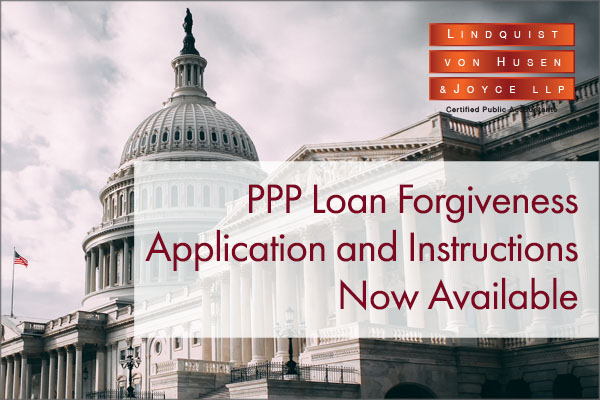
The Small Business Administration (SBA) has finally released the much-anticipated guidance on how borrowers can request forgiveness of their Paycheck Protection Program (PPP) loans. Borrowers will file SBA Form 3508, Paycheck Protection Program Loan Forgiveness Application. Form 3508 is an 11-page application with instructions that provide guidance on calculating the amount of loan forgiveness.
The application form consists of four components: (1) the PPP Loan Forgiveness Calculation Form; (2) PPP Schedule A; (3) the PPP Schedule A Worksheet (for computing the full-time equivalency (FTE) and salary/hourly wage reductions); and (4) the (optional) PPP Borrower Demographic Information Form. Borrowers must submit (1) and (2) to their lenders along with various supporting documentation.
A borrower must retain all records relating to the PPP loan in its files for six years after the date the loan is forgiven or repaid in full and permit authorized representatives of SBA to access such files upon request.
Some highlights to note:
- A borrower with a biweekly (or more frequent) payroll schedule may choose either the eight weeks (56 days) starting on the date of the loan disbursement (Covered Period) or the eight weeks (56 days) beginning on the first day of its first pay period following loan disbursement (Alternative Payroll Covered Period) to determine the eligible payroll costs a borrower may include in its forgiveness amount.
- For eligible non-payroll costs, only Covered Period applies.
- Eligible payroll costs include (i) cash compensation payroll costs; (ii) non-cash compensation payroll costs; and (iii) cash compensation to owners.
i. Cash compensation payroll costs incurred but not paid during the last pay period of the Covered Period or the Alternative Payroll Covered Period are eligible for forgiveness if paid on or before the next regular payroll date. Otherwise, cash compensation payroll costs must be paid during the Covered Period or the Alternative Payroll Covered Period.
• Cash compensation payroll costs are capped at $15,385 (the eight-week equivalent of $100,000 per year) for each employee.
ii. Non-cash compensation payroll costs include employer portion of employee health insurance, employer contributions to employee retirement plans, and employer state and local taxes assessed on employee compensation. Instructions for PPP Schedule A indicate eligible costs are amounts paid during the Covered Period or the Alternative Payroll Covered Period.
iii. Cash compensation to owners, including owner-employees, self-employed individuals, or general partners, is capped at $15,385 (the eight-week equivalent of $100,000 per year) for each owner or the eight-week equivalent of the owner’s compensation in 2019, whichever is lower. Instructions for PPP Schedule A indicate eligible costs are amounts paid during the Covered Period or the Alternative Payroll Covered Period.
- Eligible non-payroll costs include business mortgage interests, leases, and utilities for agreements in force before February 15, 2020. These costs must be paid during the Covered Period or incurred during the Covered Period and paid on or before the next regular billing date, even if the billing date is after the Covered Period.
- Eligible non-payroll costs cannot exceed 25% of the total forgiveness amount.
- The PPP Loan Forgiveness Calculation Form clarifies the order of calculating reductions in loan forgiveness. The sum of eligible payroll and non-payroll costs is first reduced by any salary/hourly wage reductions, to be followed by any decrease in FTE.
- The loan forgiveness amount will be reduced if the salaries or hourly wages of certain employees were reduced by more than 25% during the Covered Period or the Alternative Payroll Covered Period as compared to those during the period from January 1, 2020 to March 31, 2020.
- The loan forgiveness amount will be reduced if the total average FTE during the Covered Period or the Alternative Payroll Covered Period was less than that during the borrower’s chosen reference period, as defined in the Instructions for PPP Schedule A.
- One FTE is based on a 40-hour work week for an employee, round to the nearest tenth. The maximum for each employee is capped at 1.0. A simplified method that assigns a 1.0 for employees who work 40 hours or more per week and 0.5 for employees who work fewer hours may be used at the election of the borrower.
- The loan forgiveness amount will not be reduced for FTE reductions during the Covered Period or the Alternative Payroll Covered Period due to (1) individuals who declined to be rehired when the borrower made a good-faith offer to rehire the employee; (2) employees who were terminated for cause; (3) employees who left voluntarily; and (4) employees who voluntarily requested and received a reduction of their hours. In all of these cases, the borrower can include these FTEs only if a new employee did not fill the position.
- The loan forgiveness amount will not be reduced for FTE or salary/hourly wage reductions if the borrower restores its FTE or salary/hourly wage level by June 30, 2020, to its FTE or salary/hourly wage level for pay period that included February 15, 2020.
- Borrowers should note that if they (together with their affiliates, if applicable) have a PPP loan in excess of $2 million, they must check a box on the application form to alert the SBA. This will presumably flag the loan for additional SBA review, as previously announced by the SBA.
- The application form does not contain an express recertification of necessity as of the date of the forgiveness application.
SBA Form 3508 can be downloaded here: https://www.sba.gov/document/sba-form–paycheck-protection-program-loan-forgiveness-application
If you have any questions, please contact us at info@lvhj.com.








